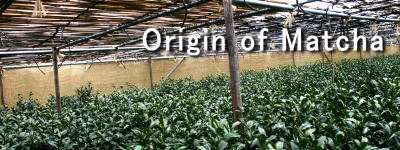Dear Sir and Madam,
We at Hibiki-an THANK YOU VERY MUCH for your continued patronage and support.
We are pleased to offer useful information for your healthy life and continued
enjoyment of Japanese green tea. In this issue, we talk about 'Origin of Matcha'.
|
Share
|

|

|
Buddhist monk Eisai popularized the idea of drinking tea for good health in the 12th century. At that time, tea was considered precious medicine, and the flavor seems to have been quite bitter. It was very long afterward that tea became flavorful.
Tea popularized by Eisai was crushed into rough powder or tiny pieces and then brewed by boiling in water. It is said that the stone mill was used to grind tea into powder form around 14th century. It is believed that at that time, tea was whisked like Matcha of today.
Today, tea leaves for Matcha are shaded from sunlight by a canopy called TANA, for 20 to 30 days just before harvest, to create a source of mellow taste, Theanine in tea leaves. The shading method started around 15th or 16th century. Though the canopy was close to the Tana canopy of today, the shading at beginning was not to create a source of mellow taste, Theanine, but to prevent damage by frost. Indeed, at beginning tea leaves were covered by canopy in February and March just before sprouts appear. In contrast, modern tea leaves are covered by canopy after sprouts appear. It is believed that tea farmers discovered by accident that tea leaves grown in shade have mellow taste, and then began to shade tea leaves from sunlight after sprouts appear to create the mellow taste.
Rikyu Sen (1522 - 1591) popularized the tea ceremony around late 16th century. Rules of the Japanese tea ceremony governed that Matcha should be served with confections or candy. So, at that time Matcha must have still had a bitter taste.
Judging from transport history of fertilizers, it was around 17th or 18th century that farmers began introducing fertilizing techniques for Matcha. Matcha taste probably became mellow and smooth around 18th century by the popularization of fertilizing techniques and shading techniques. It is said that high quality Matcha at the beginning of the 19th century was very mellow and smooth, similar to the high quality Matcha of today.
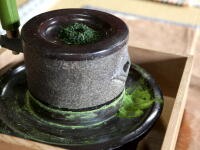 |
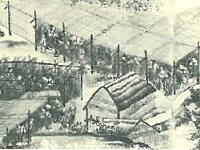 |
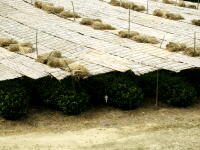 |
| Traditional stone mill following the traditional design from long ago. |
Printing of TANA canopy long ago. It looks very much the same as today's HONZU TANA canopy. (Reference from UJI SEICHA EMAKI at KONNICHI AN Library) |
Today's HONZU TANA canopy, following the traditional design, looks the same as long ago. |
Are you enjoying your green moments? Hibiki-an encourages those who love
to drink green tea. If you have any requests or questions regarding our
teas or services, please don't hesitate to contact us. We sincerely hope
that you enjoy genuine Hibiki-an Japanese green tea direct to you from
Kyoto, Japan.
Sincerely yours,
Atsushi Yasui
We have been following the green tea sprouts from early spring when the tea trees put out their first new buds to the harvest of Shincha, the first tea of the year. Now, we bring you the latest breaking news and information from Hibiki-an's tea farm in Ujitawara in Kyoto!
Around April 25:
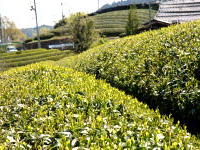 |
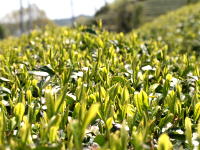 |
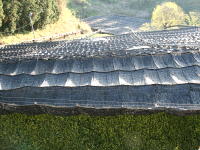 |
| Tea sprouts grow quickly and vigorously |
Tea sprouts shine in the breeze |
TANA canopies, too shake with the wind |
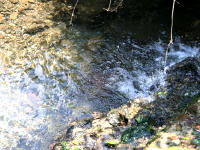 |
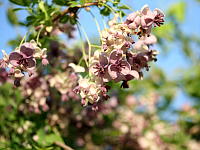 |
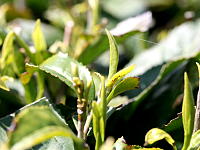 |
| Clear brook runnng in and around our tea farms |
Japanese wisteria swaying in the breeze |
Tea leaves for Sencha(Shincha) as of April 25 |
Over the last seven days (April 19 to 25) the minimum temperature each day was about 6C (41F) to 12C (54F) in Ujitawara, Kyoto. Thus our little green tea sprouts continue to grow and have transitioned from brand new to the middle stage of their growth cycle. It is said that sprouts grow quickly and vigorously when the minimum temperature each day is consistently over 10C (50F).
The appearance of the tea farm changes dramatically after the first and second tea sprouts open. The tea farms change from dark green to a cheerful yellow-green. A bright green sea of tea sprouts shine in the breeze and the sunlight. To see the tea sprouts shine brings joy because the yellow-green color of the young sprouts will deepen in about two weeks when the third or fourth tea sprouts open. It signifies the arrival of the tea harvest.
This year's harvest will probably start in two weeks or more on May 7 or 10 which is the usual time of year or perhaps a few days later than usual.
Shincha teas:
Shincha (the first tea of the year) is harvested starting at the beginning
of May in Kyoto. We are planning to sell some limited edition Shincha teas
only available this Shincha harvest season. Celebrate our first tea harvest
of the year with Hibiki-an's Shincha and enjoy the remarkable fresh flavor,
which can only be experienced once every year! Please wait and see!
What is Shincha?: click here
We would like you to rediscover the value of our Tasting Set items for
monthly recommendation. Our tasting sets feature our most popular items
and are all excellent values. They are ideal for those who would like to
try a taste test to learn which is their favorite tea, or who would like
to enjoy less quantity of some kinds of tea. These tea set items are especially
perfect for those who are new to green tea to learn the differences between
each type of tea.

|
|
This is our most popular tea tasting set. We chose and combined three of our most popular teas: Gyokuro Superior, Sencha Superior, and Sencha Fukamushi Superior...
|

|
|
Karigane is made from the stems of Gyokuro and high grade Sencha. We combined three valuable Karigane items: Gyokuro Karigane Superior, Sencha Karigane , and Houjicha Karigane...
|

|
|
Genmaicha and Houjicha contain less caffeine than other Japanese teas. And they are suitable for everyday because of the affordable prices. We chose and combined four of our most unique and delightful teas to make this special set: Genmaicha, Genmaicha Matcha-iri, Houjicha, and Houjicha Karigane...
|

|
|
We chose and combined three of our most popular and healthy organic green teas: Organic Sencha Superior, Organic Genmaicha Matcha-iri, and Organic Houjicha...
|

|
|
We chose and combined three of our most popular and basic Teabag teas: Teabag Gyokuro, Teabag Sencha, and Teabag Houjicha...
|

|
|
We chose and combined three of our most popular Teabag teas: Teabag Organic Sencha, Teabag Genmaicha Matcha-iri, and Teabag Houjicha...
|
"What is Tasting Set?" page: click here
We have arranged for 10 limited edition, and two new Matcha Starter Sets.
The 10 limited edition Matcha Bowl are all available only this spring and
summer season.
Some of the items are designed with modern, sophisticated style, while others use traditional handcrafted techniques for a more traditional design.
We have chosen items that are of exceptional quality yet reasonable in price. They will certainly enrich and enhance your green moment.

|
|
HAJIRAI of this name means bashfulness in Japanese. White glaze and pink color on the base, both outside and inside, and its unique form, remind us of the blush of a maiden. It also reminds us of the breezy and carefree springtime...
|

|
|
This Matcha bowl is graceful and dignified. The combination of the paintings and the decoration of gold brings an extremely elegant atmosphere. The harmony and contrast of natural soil and the elegant decoration are very rare and unique...
|

|
|
ORIBE is a green color used in traditional pottery. MENTORI describes the surfaces created by carving away the clay. The traditional green color glaze, ORIBE green, is named after historical tea master, Oribe Furuta...
|

|
|
This porcelain Matcha Bowl creates an aura of elegance and unique pleasant cooling sensation. HANA of this name means flower and KESSHO means crystal in Japanese. This item is finished by the technique called Crystal glaze...
|

|
|
AYAME of this name means iris in Japanese. Traditional drawing patterns on this Matcha Bowl are dynamically and elegantly shaped with a unique and ingenious form. Orange patches called GOHONDE deepen the atmosphere...
|

|
|
KYO of this name means KYOTO and HARU means spring in Japanese. SAKURA cherry blossoms, painted on this Matcha Bowl, are well-loved flowers, symbolizing springtime, in Japan. Considering the price and quality, this Matcha bowl is an outstanding value...
|

|
|
This Matcha bowl is one of the most traditional and standard called IRABO CHAWAN. This style features a yellow IRABO glaze and the typical form called IDO GATA...
|

|
|
This Matcha Bowl has a tranquil, elegant, and a little cute atmosphere, and when held in both hands, creates a calming effect. Matcha Bowl having such character is quite rare, but sought after...
|

|
|
HYO RETSU, which means cracked ice in Japanese, is a very traditional Japanese glazing technique. This technique intentionally creates an intricate network of thin surface cracks in the glaze...
|

|
|
This Starter Set is the minimum set including only the essential tea ware for a perfect bowl of Matcha. And this includes KYO no HARU handcrafted Matcha Bowl, painted elegantly by typical Kyo Yaki style...
|

|
|
This Starter Set is the minimum set including only the essential tea ware for a perfect bowl of Matcha. IRABO handcrafted Matcha Bowl and KUROCHIKU Banboo Whisk create the WABI SABI atmosphere...
|
Teapots / Cups shopping page: click here
Matcha Bowls / Accessories shopping category: click here
Have you chosen a Mother's Day gift? In Japan, green tea is often presented as a gift because it symbolizes a wish of good health and longevity. This tradition of giving green tea as a gift is as popular today as it has been throughout history. We give the gift of green tea for good health and long life of friends, family, and loved ones. A gift of genuine Japanese tea would make a perfect gift this Mother's Day.

|
|
We have chosen and combined some of our most popular items which would make perfect gifts for friends, family, and professional colleagues, or any special or romantic occasion such as holidays, birthdays, Valentine's Day, weddings, or the purchase of a new home...
|

|
|
We would like to introduce some of the most popular items in our Gifts category, which have good reputations and are most often chosen by our customers to send as gifts...
|

|
|
We added some FUROSHIKI Gift Items to respond to customers' requests. They are carefully wrapped with FUROSHIKI Japanese traditional wrapping fabric. Please take a look. These items would make perfect gifts for friends, family, and professional colleagues, or any special or romantic occasion!...
|

|
|
Japanese tea combined with handcrafted tea ware makes a wonderful gift.
Atmospheric handcrafted tea ware enhances the green moment. Since these
are our most popular and well-loved items, you can get an idea of what
might make the perfect gift!...
Teapots / Cups shopping category: click here
Matcha Bowls / Accessories shopping category: click here
|

|
|
Japanese tea combined with handcrafted tea ware makes a wonderful gift. Listed below are all popular items. Since these are our most popular and well-loved items, you can get an idea of what might make the perfect gift!...
Japanese Snacks / Candy shopping category: click here
|

|
|
The combination of green tea with gold flakes makes a beautiful presentation. Gold is an ancient symbol of prosperity, and adds significance to any special occasion. Would you check our Golden Celebration Tea and the Gift items once?...
|

|
|
Would you prefer regular items, Gyokuro, Sencha, Matcha, Organic, Teabag, Tea ware, and so on? If so, would you visit each shipping category?...
|
"Celebration Gifts in Japan" page: click here
YOHKAN sweet bean jelly is one of the most popular and classic confections
in Japan along with OHIGASHI candy and OKAKI rice cracker. Indeed AN bean
jam, which is the main ingredient of YOHKAN, is the most essential ingredient
of WAGASHI traditional Japanese confections. It has a unique texture and
sweetness which pairs well with all kinds of Japanese tea.
We developed four flavors of YOHKAN with an established AN bean jam manufacturer
located in Kyoto. Our four flavors of YOHKAN are manufactured with careful
attention to quality and domestic ingredients...
(visit the shopping page: click here)
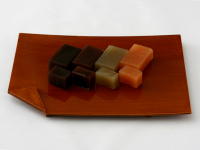 |
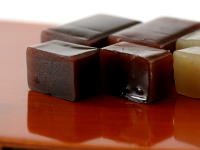 |
 |
| Starting from the left to right, OHSHIMA, OGURA, YUZU, and UME |
|
Wrapped and decorated with WASHI Japanese paper |
YOHKAN (sweet bean jelly) US$17.50 shopping page: click here
Japanese Snacks / Candy shopping category: click here
(Notice) Our Website is Secure; NO Risk From "Heartbleed" SSL
issue
Our website uses Secure Socket Layer (SSL) encryption for all your online
transactions, and is quite secure because the SSL is a different version
from the one having vulnerability. We have checked our website and have
confirmed that your online payment credentials are not at risk from recent
security issues such as "Heartbleed". Furthermore, we don't intrinsically
store any credit card information on our website. Our gateway company,
CyberSource has confirmed that the system is secure. Please feel free to
order from our site as usual.
Account info
You can view your account info, including your order history, as well as change your email, password, or home address or add a new shipping address to your address book by clicking here.
Or if you prefer, we are happy to update your account info for you. Just let us know. Please don't hesitate to contact us!
To unsubscribe from Hibiki-an Newsletters
You can remove your email address from the mailing list by clicking here.
Or if you prefer, email us with your FULL NAME and we will immediately remove your email address from the mailing list.
Japanese Green Tea Hibiki-an
36 Shimonoto Yuyadani
Ujitawara, Kyoto 610-0221
Japan
http://www.hibiki-an.com
